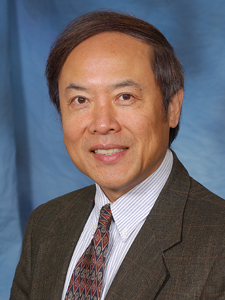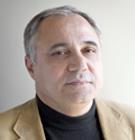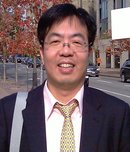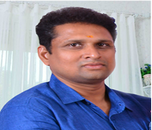Day 1 :
Keynote Forum
Donglu Shi
University of Cincinnati, USA
Keynote: In-Vitro Depth-Dependent Photo thermal Ablation of Human Adenocarcinoma by Polystyrene Stabilized Fe3O4
Time : 09:30-10:10

Biography:
Donglu Shi received his Ph. D. in Materials Science and Engineering in 1986 from the University of Massachusetts at Amherst. In 1995, Donglu Shi joined the faculty as an Associate Professor in the Department of Materials Science and Engineering at University of Cincinnati. He was promoted to the full professor position,rnwith tenure, in 2001 at University of Cincinnati. He is currently the Chair of the Materials Science and Engineering Program at the University of Cincinnati. Donglu Shi has so far published 250 refereed SCI journal publications including Physical Review Letters, Nature, ACS Nano, and Advanced Materials.
Abstract:
Nanoparticle mediated photo thermal ablation of cancerous tissue shows promising results as an efficacious treatment method. However it is important to understand the effects of greater laser attenuation on photothermal efficacy mediated by changes in the scattering and absorption profiles of soft tissue. Photothermal efficacy using a near infrared (NIR) 785nm laser irradiating polystyrene (PS) stabilized magnetite (Fe3O4) nanoparticles (PS-Fe3O4) is examined on MDA-MB-231 human mammary gland adenocarcinoma in-vitro. Agarose gel columns of various depths were created to simulate soft tissue and subsequently used for NIR laser attenuation. PS was found to significantly improve magnetite nanoparticle stability in modified Hank’s Balanced Salt Solution, serum containing media, reduces innate toxicity over 48 hours compared to uncoated magnetite, and allows for effective hyperthermic ablation. Agar gel layers provided similar optical attenuation in the NIR region to soft tissue and provided a convenient base gel material for advanced soft tissue modeling. The NIR laser power usedrndid not solely affect cellular viability, but allowed for photothermal ablation through all examined agar gel depths.
Keynote Forum
Rafael Vazquez-Duhalt
National Autonomous University of Mexico, Mexico
Keynote: Design of a VLP‑nanovehicle for CYP450 enzymatic activity deliveries
Time : 10:10-10:50

Biography:
Rafael Vazquez‑Duhalt is working as a full Professor at the Center for Nanosciences and Nanotechnology of the National University of Mexico. He earned his PhD degree in Biological Sciences from the University of Geneva, Switzerland. In addition, he carried out a three-years Post-doctoral work in the University of Alberta, Canada. He has been a visiting Professor at the University of Maryland and at the University of California, San Diego. He earned the Scopus Prize from Elsevier Publisher as Mexican researcher with higher H factor in Biotechnology and Agronomy fields in 2011, the Research Merit State Prize from the Morelos State Government in 2009, and “Thomson-Reuters” Prize to the most cited Mexican research article in Microbiology in the decade 1999-2009 in 2009. He is the author of 3 patents, published 2 books and more than 145 scientific articles.
Abstract:
The intracellular delivery of enzymes for therapeutic use has a promising future for the treatment of several diseases such as genetic disorders and cancer. Virus-like particles offer an interesting platform for enzymatic delivery to targeted cells because of their great cargo capacity and the enhancement of the biocatalyst stability towards several factors important in the practical application of these nanoparticles. We have designed a nano-bioreactor based on the encapsulation of a cytochrome P450 (CYP) inside the capsid derived from the bacteriophage P22. An enhanced peroxigenase, CYPBM3, was selected as a model enzyme because of its potential in enzyme prodrug therapy. A total of 109 enzymes per capsid were encapsulated with a 70% retention of activity for cytochromes with the correct incorporation of the heme cofactor. Upon encapsulation, the stability of the enzyme towards protease degradation and acidic pH was increased. Cytochrome P450 activity was delivered into human cervix carcinoma cells via transfecting P22-CYP nanoparticles with lipofectamine. This work provides a clear demonstration of the potential of biocatalytic virus-like particles as medical relevant enzymatic delivery vehicles for clinical applications.
Keynote Forum
George Altankov
Institute for Bioengineering of Catalonia, Spain
Keynote: Mesenchymal Stem Cells Behaviour in Nano fibrous Environment
Time : 11:10-11:50

Biography:
George Altankov is ICREA Research Professor in the Institute for Bioengineering of Catalonia. He got his MD in 1974 in Varna Medical Institute, Bulgaria, where also accomplished his PhD (1984). In 1991-1993 he made his postdoc in Southwestern Medical School at Dallas performing studies on the molecular mechanisms of cell adhesion. During his subsequent work in the Bulgarian Academy of Sciences (1985-2005) he grew up to full professor, head of department and deputy Director of the Institute of Biophysics in Sofia. His studies, performed in close collaboration with GKSS Research Centre (Germany), were among the first highlighting that tissue compatibility of materials is strongly dependent on the ability of cells to reorganize surface associated matrix proteins, such as fibronectin, vitronectin, fibrinogen and collagen. His studies resulting in more than 100 publications in peer reviewed journals and books that are frequently cited.
Abstract:
Mimicking the complex intricacies of the extracellular matrix (ECM) including three dimensional configurations were traditionally used for producing living tissues from stem cells. Electrospinning is a technique capable of fabricating nanofibers (NFs) with dimensions similar to those of the natural ECM. An advantage of electro spun NFs is that they can be further designed for organization and cell binding properties which turn them within the most promising scaffold for regenerative Nanomedicine. Here we report on the use of a novel hybrid, fibrinogen/polylactic acid (FBG/PLA) nanofibers to control the overall behaviour and differentiation potential of human adipose derived mesenchymal stem cells (ADMSCs). We were particularly interested on the dorsal and ventral cell response to nanofibers organization (random vs. aligned). We found that upon ventral contact with random nanofibers the cells developed a stellate-like morphology with multiple projections where the well-pronounced focal adhesion complexes suggest a successful cellular interaction. Time-lapse analysis however showed significantly lowered cell movements resulting in relatively short distance that they traverse in multiple directions. Conversely, an elongated cell shape with extended actin cytoskeleton and significantly increased cell mobility were typically observed when cells adhering on aligned NFs. To further follow the dorsal cell response (in third dimension) artificial wounds were created on confluent cell layers and covered with either random or aligned NFs. Time-lapse analysis showed significantly faster wound coverage (within 12 h) upon contact of cells with aligned nanofibers vs. almost absent directional migration on random samples. However, quantitative reverse transcription-polymerase chain reaction analysis for Collagen 2, Collagen 10 and SOX9 genes expression showed favourable chondrogenic response of human ADMSCs cultured on random nanofibers (50 days in complete chondrogenic medium) compared to aligned ones indicating that temporary immobilisation of stem cell might promote their differentiation.
Keynote Forum
Rafael Vazquez-Duhalt
National Autonomous University of Mexico, Mexico
Keynote: Design of a VLP‑nanovehicle for CYP450 enzymatic activity deliverys
Time : 10:10-10:50

Biography:
Rafael Vazquez‑Duhalt is working as a full Professor at the Center for Nanosciences and Nanotechnology of the National University of Mexico. He earned his PhD degree in Biological Sciences from the University of Geneva, Switzerland. In addition, he carried out a three-years Post-doctoral work in the University of Alberta, Canada. He has been a visiting Professor at the University of Maryland and at the University of California, San Diego. He earned the Scopus Prize from Elsevier Publisher as Mexican researcher with higher H factor in Biotechnology and Agronomy fields in 2011, the Research Merit State Prize from the Morelos State Government in 2009, and “Thomson-Reuters” Prize to the most cited Mexican research article in Microbiology in the decade 1999-2009 in 2009. He is the author of 3 patents, published 2 books and more than 145 scientific articles.
Abstract:
The intracellular delivery of enzymes for therapeutic use has a promising future for the treatment of several diseases such as genetic disorders and cancer. Virus-like particles offer an interesting platform for enzymatic delivery to targeted cells because of their great cargo capacity and the enhancement of the biocatalyst stability towards several factors important in the practical application of these nanoparticles. We have designed a nano-bioreactor based on the encapsulation of a cytochrome P450 (CYP) inside the capsid derived from the bacteriophage P22. An enhanced peroxigenase, CYPBM3, was selected as a model enzyme because of its potential in enzyme prodrug therapy. A total of 109 enzymes per capsid were encapsulated with a 70% retention of activity for cytochromes with the correct incorporation of the heme cofactor. Upon encapsulation, the stability of the enzyme towards protease degradation and acidic pH was increased. Cytochrome P450 activity was delivered into human cervix carcinoma cells via transfecting P22-CYP nanoparticles with lipofectamine. This work provides a clear demonstration of the potential of biocatalytic virus-like particles as medical relevant enzymatic delivery vehicles for clinical applications.
- Nanomedicine and Drug Delivery | Nanomedicine and Nanotheranostics | Nanomedicine and Nanobiotechnology
Location: Pailin 2

Chair
Chandrashekhar V Kulkarni
University of Central Lancashire, United Kingdom
Session Introduction
Chandrashekhar V Kulkarni
University of Central Lancashire, UK
Title: Applications of Lipid Nanostructures and Hybrid Systems for Drug Delivery
Time : 11:50-12:20

Biography:
Chandrashekhar V Kulkarni received his PhD in Chemical Biology from University of London with a Marie Curie Fellowship at Imperial College London (2005-2008). Earlier, he completed his BSc (1999) and MSc (2001) from Shivaji University Kolhapur, India and worked in NCL, Pune. He had a few postdoc stints at University of Graz-Austria, University of Bayreuth-Germany and University of Cambridge-UK. In March 2013, he started ‘Lipid Nanostructures Laboratory’. Some of his research interests include model biomembranes, nanostructured lipid particles as carrier systems, and novel nano-bio-applications of lipid nanostructures. He published several papers in these areas. He is currently the Editor of the Elsevier Book Series: Advances in Biomembranes and Lipid-Assemblies.
Abstract:
Being amphiphilic in nature, lipid molecules self-assemble into various nanostructures in aqueous environment. The structural geometries vary from simple spherical to complex 3-dimensional architectures. The applicability of these lipid phases is enhanced by dispersing them into particulate form. These dispersions take the form of oil-in-water emulsions which require either or a combination of stabilizer and high energy. Interesting thing to note is that the original (before dispersion) self-assembly is retained inside the dispersed lipid particles. Recently, we have developed a hybrid system based on various carbon nanotubes (CNTs) and lipid molecules. Both of these components act as mutual stabilizers. Currently, both - CNTs and nanostructured lipid particles are being explored for their drug delivery applications independently. However, our hybrid system combines properties of both the constituents. Another hybrid system is based on immobilization of nanostructured lipid particles in hydrogel films. Fabrication, characterization and applications of these hybrid drug carrier systems will be presented.
Ming-Jun Tsai
China Medical University, Taiwan
Title: Development of temperature-sensitive PEGylated nanostructured lipid carrier for co-delivery of gemcitabine and Baicalein against A549 cell line
Time : 12:20-12:50

Biography:
Ming-Jun Tsai graduated from School of Medicine, Chung Shan Medical University and finished his PhD program on Cheng-Kung University. Dr. Ming-Jun Tsai is now the Chief of Department of Neurology, China Medical University-an Nan Hospital and the Assistant Professor of China Medical University, Taichung, Taiwan. Dr. Tsai focused on the research of drug delivery in clinical diseases. He has published more than 20 papers in drug delivery in clinical diseases, especially in neurologic diseases including stroke and parkinson’s diseases.
Abstract:
Gemcitabine hydrochloride is a nucleoside analog that phosphorylated by deoxycytidine kinase to active from inhibiting cellular DNA synthesis. It is widely used to treat solid tumors including colon, lung, pancreatic, breast, bladder and ovarian cancers. Baicalein (5,6,7-trihydroxyflavone) is a flavonoid derived from the root of Scutellaria Baicalensis Georgi, a medicinal plant traditionally used in Asian medicine. Baicalein is well known as a 12/15-lipoxygenase and Xanthine oxidase inhibitor for treatment of inflammation, hypertension, cardiovascular diseases, neuronal cell damage and bacterial infections. This study was designed to investigate whether combination therapy with gemitabine hydrochloride and baicalein enhances antitumor efficacy in A549 cell line. In cytotoxicity study, we found combined gemcitabine hydrochloride and baicalein on A549 cell line showed low IC50 that implied gemcitabine hydrochloride and baicalein might display synergistic antitumor effect. In order to co-delivery gemcitabine hydrochloride and baicalein simultaneously to cancer cell, we used nanostructure lipid carrier as drug vehicle and added functional moieties to increase antitumor efficacy. The results showed that the E.E.% of gemcitabine hydrochloride and baicalein was increased by added vitamin E in the formulation. The average size of carrier was decreased by PEG-25 stearate added. In the cell uptaken by A549 cell line, the formulation with the multi-functional modified had better tumor inhibition than the original formulation.
Yogita Patil-Sen
University of Central Lancashire, UK
Title: Superparamagnetic Iron Oxide Nanoparticles for Magnetic Hyperthermia Applications
Time : 12:50-13:20

Biography:
Yogita completed her PhD from the University of Manchester, UK under the guidance of Prof. Gordon Tiddy and Dr. Christine DeWolf. Currently, she is a Daphne Jackson Fellow at the University of Central Lancashire (UCLan) and her research is jointly funded by the Royal Society of Chemistry and UCLan. Yogita’s research interests are in the field of synthesis of different types of nanoparticles for targeted drug delivery and cancer therapy. She has published nine research articles in high impact factor international journals. Yogita is a member of the Royal Society of Chemistry and the American Chemical Society
Abstract:
Superparamagnetic iron oxide nanoparticles (SPIONs) are of great interest due to their potential applications in hyperthermia cancer therapy and targeted drug delivery. Hyperthermia is considered as a supplementary treatment to the conventional surgery, chemotherapy and radiotherapy, all of which lack specificity and suffer from tremendous side effects. The hyperthermia treatment is based on the fact that SPIONs, when exposed to a varying magnetic field generate heat due to magnetic hysteresis loss. Due to their superparamagnetic nature, when SPIONs are subjected to alternating magnetic field, the particles become powerful heat sources killing cancer cells which are more sensitive to temperatures above 41 °C than the normal cells. The amount of heat generated by SPIONs is strongly dependent upon their magnetic properties, which in turn is determined by their physico-chemical properties i.e. size and shape. Although, typically particles in the size range of 10-20 nm show the best superparamagnetic properties, the major problem associated with such ultra-fine particles is their agglomeration which reduces their dispersibility and hence their intrinsic stability over longer periods of time. Coating SPIONs with biocompatible materials such as lipids, peptides and silica provides a good strategy to protect magnetic nanoparticles. However, coating of SPIONs may alter their magnetic properties significantly which is undesirable for their bioapplications. Therefore, SPIONs should be coated in such a way that coating provides favourable characteristics preserving the desirable properties of SPIONs intact. Our research focuses on synthesis of various types of core-shell type nanoparticles for magnetic hyperthermia cancer therapy and drug delivery applications.
Gisèle Clofent-Sanchez
Bordeaux University, France
Title: Theranostic of atherosclerosis using human antibody-targeted multi-modal nanoparticles for in situ drug delivery
Time : 14:00-14:30

Biography:
Gisele Clofent-Sanchez is currently a Director of Research in Bordeaux University (France). She is head of the “Molecular Targeting of Atheroma” group. She obtained her PhD in Immunology and Molecular Biology from the University of Montpellier in 1989. She became a permanent researcher in 1992 in the laboratory of Alan Nurden into the field of platelet immunology. She moved to translational approaches in atherosclerosis in 2003 and has acquired expertise in in vivo phage-display. Her team works on the selection of human antibodies recognizing molecules in the pathological context, for their transfer in potential diagnostic and/or therapeutic agents
Abstract:
Atherosclerosis is the leading cause of death in the world. This pathology is an inflammatory disease that results from an initial activation of the endothelial cells with further enhancement of oxidative stress, lipid and leucocyte recruitment. The lesions evolve to vulnerable plaques presenting large lipid cores covered by a thin fibrous cap at high risk of rupture and thrombi formation, thus precipitating the clinical conditions of stroke and myocardial infarction. Nowadays, there is an increasing interest in developing theranostic approaches combining molecular imaging and in situ drug delivery. Targeting the cellular and molecular components that underlie the risk of rupture is the stepping-stone for efficient imaging of vulnerable plaques and personalized therapy. Here, human antibodies (HuAbs) selected by in vivo phage-display in animal models are proposed as targeting ligands to functionalize nucleolipid-based nanoparticles loaded with iron oxide and drugs for Magnetic Resonance Imaging-guided therapy of atherosclerosis. HuAbs are mandatory for repeated use in humans in order to minimize immunogenic reactions. There is currently substantial interest to design HuAbs targeted nanoparticles with the aim of a direct translation into the clinic. Thanks to in vivo phage-display technology, the HuAb candidates have been selected for their targeting capabilities in the context of the pathology and have the potential to gain insight into the most relevant targets over-expressed in the disease by mass spectrometry analysis of immunoprecipitated antigens. In fine, efficient drug encapsulation may allow in situ drug delivery which provides main advantages over systemic administration, avoiding for example potential deleterious side effects.
Palanivel Rameshthangam
Alagappa University, India
Title: In-vitro and in-silico studies on curcumin loaded chitin and chitosan nanoparticles from shrimp shells
Time : 14:30-15:00

Biography:
Palanivel Rameshthangam has completed his PhD at 2008, from Department of Biotechnology, University of Madras, India. After completing his postdoctoral studies, he joined as Assistant Professor at Alagappa University, India. He has got Indian Patent for the identification of novel antiviral agent from the plant Pongamia pinnata. He has published more than 15 research papers in peer reviewed International journals and also published one book. Over all he has 124 citations, 5 h-index and 3 i10-index of citation indices. One of his research article published in New Journal of Chemistry (doi:10.1038/nindia.2016.27) was cited in Nature India and the other in Virus Research 110(2005) 133 -141 was selected as 14th among the Science Direct TOP 25 articles in the subject area Immunology and Microbiology. He has presented his research findings in more than 50 conferences, both National and International level. He is also serving as a reviewer for reputed journals.
Abstract:
Curcumin, is an active ingredient of turmeric, have several biological activities and used as a therapeutic agent for various diseases. However, some physical properties such as low solubility, sensitive to pH values and faster degradation in the digestive system limit the application of curcumin. Hence we aimed to evaluate the curcumin delivery potential of chitin and chitosan nanoparticles which are isolated from the shrimp shells. Chitin is a second most abundant biopolymer in the world, and chitosan is a deacetylated derivative of chitin. We have synthesized chitin nanoparticles (CNP) and chitosan nanoparticles (ChNP) from the shrimp shells and characterized using FTIR, XRD, SEM and DLS studies. Curcumin loading (CNP/Cur and ChNP/Cur) was performed at various weight ratios (0.5:1, 1:1, and 1:2) and encapsulation efficiency was calculated. At 1:1 weight ratio of CNP: Cur and ChNP: Cur, shows maximum (87.5% and 93.4% respectively) encapsulation efficiency. In-vitro release kinetics was performed at two different pH (2.5 and 7.4) and confirmed that the drug release was stable, higher, time dependent at pH 7.4. FTIR analysis of Curcumin loaded nanoparticles evidenced that there was no chemical interaction, only the physical interaction was observed between CNP/Cur and ChNP/Cur. In-silico molecular docking studies of CNP:Cur and ChNP:Cur has showed the docking score of 0.647 and -0.427 respectively, is in good agreement with in-vitro studies. Thus the present study revealed significant physiochemical nature, strength and interacting sites of CNP and ChNP nanoparticles with curcumin and could be used for drug delivery applications.
Rakesh Kumar Sharma
University of Delhi, India
Title: Multifunctional inorganic nanoparticles (Synthesis and biological applications)

Biography:
Rakesh Kumar Sharma, Currently Assistant Professor in Department of Chemistry, University of Delhi, India has completed his PhD at the age of 31years from the same University. He has published about 25 papers in reputed journals and delivered oral and invited talks in many conferences. Three students have already got their PhD under him and four more are registered at present.
Abstract:
Nanomedicine in simple words is the medical application of nanotechnology and concerns monitoring, repair, construction and control of human biological systems using engineered nanoscale materials. It is an interdisciplinary research field and involves chemistry, physics, biology, engineering and medicine and has great potential for early and accurate detection, diagnosis and treatment of various deadly diseases like cancer. It overcomes many of the difficulties experienced by normal medical approaches in the treatment of various disorders. Now a day there is growing interest for the synthesis of nanoscale materials with a confined shape and controlled size under normal conditions and there are many approaches available for the synthesis of these particles. Reverse micelles (or Water-in-oil microemulsion) provides an interesting synthesis approaches as it enables the synthesis of encapsulated nanoparticles with controlled size distributions. Inorganic nanoparticles, whose structures exhibits significantly novel and improved chemical, physical and biological properties have elicited much interest. In my presentation I will discuss the synthesis (mainly using reverse micellar approach) and some potential applications of inorganic nanoparticles (like gold, silica, Gadolinium oxide etc.) in therapeutics. I will discuss how the activity and stability of biomolecules like enzymes can be controlled by direct encapsulation in the cavity of these inert, non-biodegradable and bio-compatible nanoparticles. I will also show how these nanoparticles serve different purposes simultaneously.
Chen-Sheng Yeh
National Cheng-Kung University, Taiwan
Title: Stimuli-responsive nanomaterial’s in cancer therapy
Time : 15:30-16:00

Biography:
Chen-Sheng Yeh received a MS degree from National Tsing Hua University, Taiwan, and a PhD degree in Chemistry from University of Georgia, USA, in 1993. He then worked as Post-doctoral fellow at Department of Chemistry in Purdue University, USA. He started as an Associate Professor at the Department of Chemistry, National Cheng Kung University, Taiwan, in 1995. He was promoted to Professor and Distinguished Professor in 2001 and 2009, respectively. Currently, he is the Coordinator of Displicine of Chemistry, Ministry of Science and Technology, Taiwan. His research focuses on the development of functional nanomaterials in biological applications and the area of nanostructured characteristics and has published over 100 SCI papers
Abstract:
The use of state-of-the-art noninvasive therapies at the organ level in modern medicine has gradually become possible. However, cancer treatment demands for spatially and temporally controlled noninvasive therapy at the cell level because nonspecific toxicity often causes complicated side effects. To increase survival in cancer patients further, combination therapy and combination drugs are explored which demand for high specificity to avoid combined drug side effects. The high specificity could be obtained by implementing stimuli-responsive nanoparticles in photo- and ultrasound-induced therapy. To refine this therapy and subsequently achieve high efficiency, novel nanomaterials can be designed and modified either to enhance the uptake and drug delivery to the cancer site, or control treatment to administer therapy efficiently. These modifications and developments have been demonstrated to achieve spatial and temporal control when conducting an in vivo xenograft. The nanoplatforms discussed in this talk include core-shell Fe3O4@Au nanotrisoctahedra, rattle-type Fe3O4@CuS nanoparticle, and H2O2/Fe3O4-PLGA polymersome.
Yun-Kai Huang
National Cheng-Kung University, Taiwan
Title: Fabrication of silica-coated hollow carbon nanospheres encapsulating Fe3O4 cluster for magnetically and MR imaging guided NIR light triggering hyperthermia and enhanced US imaging
Time : 16:20-16:40

Biography:
Yun-Kai Huang has completed his BS degree from National Cheng-Kung University (NCKU), Taiwan and Master’s degree in Department of Chemistry from the same university. His research mainly focused on the synthesis and applications of nanomaterials.
Abstract:
In this study, the yolk-shell silica coated iron oxide@carbon nanospheres (IONP@h-C) were synthesized to act as a multifunctional theranostic nanosystem for cancer treatments. IONPs were synthesized, and then encapsulated in the hollow carbon shell through the mixed micelles, polymerization, hollowing and carbonization processes. With a silica shell coating on IONP@h-C, the hybrid nanopsheres were able to escape from condensing and sintering consequence, causing aggregation, through the annealing process. The dispersed nanospheres in aquous solution were eligible for biomedical studies in vivo. The graphitic carbon shell displayed near-infrared (NIR) absorption and were susceptible to photothermal hyperthermia upon NIR light irradiation. Because of the presence of the magnetic IONP, the mice bearing malignant tumors were subject to magnetical and magnetic resonance imaging guided photothermal ablation of tumors. Furthermore, the void of the IONP@h-C has allowed us to load low boiling point of perfluorohexane. Because of the heating effect derived from IONP@h-C exposed to NIR light irradiation, the vaporization of perfluorohexane has given the additional echogenic source for ultrasound imaging (US). Therefore, the in situ US imaging can be monitored upon NIR light exposure of the tumor sites.
